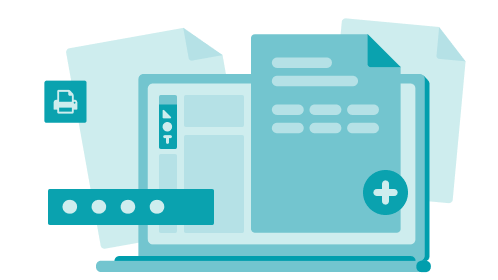Whether you’re at the very first stages of starting your own business, or you’ve been a small business owner for a while, you may focus a lot of your time on profits and revenue. Both are important, however, so is managing your cash flow.
Poor cash flow management can lead to a shortage on cash, and less cash could mean leaning too heavily on credit and loans. Luckily, managing cash flow is relatively easy. Simply put: You need to know how much money you have, to spend it properly.
But what is cash flow, really?
It’s a measurement that tells you the exact amount of cash coming into and going out of your business over a certain period of time. As you can probably guess, positive cash flow is good — it’s when you have more cash coming in than going out. This means you can pay your bills, your employees, and more. Negative cash flow means you’re spending more money than you have coming in, so you can’t afford to cover your expenses.
How is cash flow different from revenue?
Revenue is the measurement of money earned, or the amount of money coming into your business. Cashflow is a net amount and measures both money coming in and going out. A few other words people use for cash flow include cash inflow, money flow or inflow.
For example, let’s say a client just paid you $10,000 and another $10,000 just came in from a loan, but you had to pay $2,000 for a new piece of equipment. Your cash flow now equals $18,000.
($10,000 + $10,000) – $2,000 = $18,000 in cash flow
Below, we’ll share how to start managing cash flow for small businesses and why it’s always important to track and understand.
Why is it important to manage cash flow?
1. It can help you see and completely understand where your money is going.
This is important so you’ll be able to see exactly where you’re spending money (i.e. the things that aren’t on a profit and loss statement).
In order to manage your cash flow you need to stay on top of your bookkeeping, create cash flow statements (more on this later), and then analyze this information. This will help you see how you could potentially increase cash flow or where you could cut costs.
Additionally, if you currently use the accrual accounting method, it’s extra important to calculate your business cash flow. Accrual accounting is when a company records revenue before receiving payment and expenses before they’re spent. While the method can help your company look at the bigger picture, it can’t tell you what you have in the bank at that exact moment. You can’t spend money you don’t have.
On the other hand, the cash accounting method is when you only record revenue once the money is in your account and expenses once they’ve been paid. If you practice cash accounting, you probably have a better understanding of your current cash flow just by looking at your accounts. Still, it’s a good idea to take a closer look by managing your cash flow and analyzing the information.
2. It helps you understand when to pursue growth or when to scale back.
OK, so, you’ve looked at your cash flow statements and you see that you’ve been overspending, whether it’s on overhead costs or production costs, this could indicate that it’s time to scale back. By scaling back, you will inherently increase your cash flow, as the amount spent will decrease.
On the other hand, you may see that your cash flow has steadily increased and it’s time for you to grow the business. Growing — from hiring more employees to increasing production — costs a lot of money. By managing your cash flow properly, you’ll be able to stay on top of these costs to make sure you always have enough working capital.
3. You can better manage your bills and pay off debts more efficiently.
Of course, if you have negative cash flow, that means that you likely don’t have enough money to pay your bills, expenses or suppliers. In turn, this could harm your company’s reputation and business relationships. However, by managing your money flow, you can see how much money you’ll have over a certain period of time and will be able to schedule payments in advance to avoid these issues.
Managing cash flow for small businesses in particular is crucial
While it’s important for all businesses to manage cash flow, no matter the size or length of operation, it’s imperative for small businesses. If you’re a new business owner, it’s the most accurate way to see how much cash you really have at any given time. It can also help you predict how much money you’ll have at the end of future months, quarters or even years. Knowing this, you can make well-informed financial decisions when you need to use your savings, borrow funds or increase your cash flow.
However, if you’re also looking to bring on investors, a cash flow statement can demonstrate the short-term viability of your company. This means how much money it brings in and how well it pays the bills.
If money is tight, you need to increase cash flow
This can be easier said than done. However, one way to increase cash flow in a given month is to speed up your accounts receivable. In other words, get people to pay you faster so you have more money available, earlier.
Let’s say you’ve completed 10 jobs and are expecting payment from those 10 clients, but they haven’t paid up. Sure, the money is coming, but it needs to physically be in your account to pay your own expenses. There are a few things you can do to try to expedite payments, like speeding up your own invoicing process, shortening payment terms, securing pre-payments or adding on late fees.
Either way, while you await payment, if you’re managing your cash flow then you’ll know not to make any large purchases.
A few other ways to increase cash flow could be increasing your number of customers, the amount of the average sale or how often people actually buy your service or product.
How to build a cash flow statement
While you can manually prepare a cash flow statement, accounting software can also generate these statements for you. The key is making sure that all of the information you enter is absolutely correct — your statement will only be as accurate as the information you provide.
There are also solutions that simplify this process, making it easy to track what you’ve been paid, what you owe, and what you spend. Lili’s accounting software streamlines your bookkeeping by eliminating the need for manual data entry, and automatically generates cash flow statements for you, as well as other financial statements.
Two cash flow management techniques to consider
Method #1: Indirect Cash Flow
The indirect cash flow method is commonly used by small businesses, as it’s fairly straightforward. When building out a cash flow statement using the indirect method, you choose a period of time and start with your net income, then make changes, like expenses and bills paid, to see how much you have on hand.
Method #2: Direct Cash Flow
This method usually takes longer and is a bit more complicated. Larger companies and corporations usually employ this approach. This method involves listing out each time cash came into the business and every single time it was used to pay a bill or an expense.
No matter which method you choose, your cash flow statement will help you find your operating cash flow, also known as OCF. This is a pretty simple calculation: Total revenue minus operating expenses will equal your OCF.
To build out a full cash flow statement, you’ll need to determine your starting balance and calculate the amount of cash from operating activities, investing activities, and all financing activities.
- Operating activities: This is the money your company brings in from its regular day-to-day operations (selling products or services).
- Investing activities: This is the money your company spent buying and selling equipment, property or other long-term assets.
- Financing activities: This is the money your company raises from investors, gets through loans or earns from selling stock, and how your company pays back.
Here’s an example of a cash flow statement:
Billy’s Boat Cleaning Business
Cash Flow Statement
| Cash Flow from Operating Activities | |
| Net Income | $8,000 |
| Additions to Cash | |
| Depreciation | $0 |
| Increase in Accounts Payable | $500 |
| Subtractions from Cash | |
| Increase in Accounts Receivable | ($6,000) |
| Net Cash from Operating Activities | $7,000 |
| Cash Flow from Investing Activities | |
| Purchase of equipment | $2,000 |
| Cash Flow from Financing Activities | |
| N/A | N/A |
| Cash Flow For the Month Ending 8/31/21 | $7,500 |
How Lili can help small businesses manage cash flow
Doing your own business accounting is no joke. Luckily, Lili combines banking and accounting software, so it’s easy to track invoices, payments and expenses all in one place.
If cash flow is tight, you can also take advantage of BalanceUp4, Lili’s fee-free overdraft protection of up to $200 on debit card purchases.
All in all, Lili’s perks add up to a better work-life balance. When you’re not looking at different platforms or worried about calculating your cash flow, you can spend less time accounting and more time running your business.





